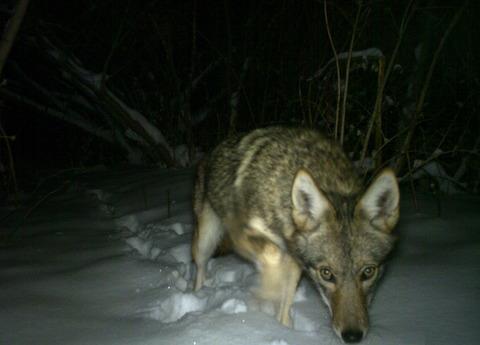当前位置:
X-MOL 学术
›
J. Anim. Ecol.
›
论文详情
Our official English website, www.x-mol.net, welcomes your
feedback! (Note: you will need to create a separate account there.)
Spatial variation in diet‐microbe associations across populations of a generalist North American carnivore
Journal of Animal Ecology ( IF 3.5 ) Pub Date : 2020-06-20 , DOI: 10.1111/1365-2656.13266 A Shawn Colborn 1 , Corbin C Kuntze 1 , Gabriel I Gadsden 1 , Nyeema C Harris 1
Journal of Animal Ecology ( IF 3.5 ) Pub Date : 2020-06-20 , DOI: 10.1111/1365-2656.13266 A Shawn Colborn 1 , Corbin C Kuntze 1 , Gabriel I Gadsden 1 , Nyeema C Harris 1
Affiliation

|
Generalist species, by definition, exhibit variation in niche attributes that promote survival in changing environments. Increasingly, phenotypes previously associated with a species, particularly those with wide or expanding ranges, are dissolving and compelling greater emphasis on population-level characteristics. In the present study, we assessed spatial variation in diet characteristics, gut microbiome, and the association between these two ecological traits across populations of coyotes (Canis latrans). We highlight the influence of the carnivore community in shaping these relationships, as the coyote varied from being an apex predator to a subordinate, mesopredator across sampled populations. We implemented a scat survey across three distinct coyote populations in Michigan, USA. We used carbon (δ13 C) and nitrogen (δ15 N) isotopic values to reflect consumption patterns and trophic level, respectively. Corresponding samples were also paired with 16S rRNA sequencing to describe the microbial community and correlate with isotopic values. Though consumption patterns were comparable, we found spatial variation in trophic level among coyote populations. Specifically, δ15 N was highest where coyotes were the apex predator and lowest where coyotes co-occurred with gray wolves (Canis lupus). The gut microbial community exhibited marked spatial variation across populations with the lowest OTU diversity found where coyotes occurred at their lowest trophic level. Bacteriodes and Fusobacterium dominated the microbiome and were positively correlated across all populations. We found no correlation between δ13 C and microbial community attributes. However, positive associations between δ15 N and specific microbial genera increased as coyotes ascended trophic levels. Coyotes provide a model for exploring implications of niche plasticity because they are a highly adaptable, wide-ranging omnivore. As coyotes continue to vary in trophic position and expand their geographic range, we might expect increased divergence within their microbial community, changes in physiology, and alterations in behavior.
中文翻译:

北美多面手食肉动物种群饮食-微生物关联的空间变异
根据定义,通才物种表现出促进在不断变化的环境中生存的生态位属性的变化。越来越多的以前与物种相关的表型,特别是那些具有广泛或扩大范围的表型,正在溶解并迫使人们更加重视种群水平的特征。在本研究中,我们评估了郊狼(Canis latrans)的饮食特征、肠道微生物组以及这两种生态特征之间的关联的空间变化。我们强调了食肉动物社区在塑造这些关系方面的影响,因为土狼从一个顶级捕食者变成了一个从属的、跨采样种群的中掠食者。我们在美国密歇根州对三个不同的土狼种群进行了一次粪便调查。我们分别使用碳 (δ13 C) 和氮 (δ15 N) 同位素值来反映消费模式和营养水平。相应的样本还与 16S rRNA 测序配对,以描述微生物群落并与同位素值相关联。尽管消费模式具有可比性,但我们发现土狼种群的营养水平存在空间差异。具体来说,δ15 N 在土狼是顶级捕食者的地方最高,在土狼与灰狼(犬狼疮)共同出现的地方最低。肠道微生物群落在具有最低 OTU 多样性的种群之间表现出显着的空间变异,发现土狼出现在最低营养水平。拟杆菌和梭杆菌在微生物组中占主导地位,并且在所有种群中均呈正相关。我们发现 δ13 C 与微生物群落属性之间没有相关性。然而,δ15 N 与特定微生物属之间的正相关性随着土狼的营养水平上升而增加。土狼为探索生态位可塑性的影响提供了一个模型,因为它们是一种适应性强、范围广泛的杂食动物。随着土狼的营养位置不断变化并扩大其地理范围,我们可能会预期它们的微生物群落内的差异会增加,生理机能会发生变化,行为也会发生改变。
更新日期:2020-06-20
中文翻译:

北美多面手食肉动物种群饮食-微生物关联的空间变异
根据定义,通才物种表现出促进在不断变化的环境中生存的生态位属性的变化。越来越多的以前与物种相关的表型,特别是那些具有广泛或扩大范围的表型,正在溶解并迫使人们更加重视种群水平的特征。在本研究中,我们评估了郊狼(Canis latrans)的饮食特征、肠道微生物组以及这两种生态特征之间的关联的空间变化。我们强调了食肉动物社区在塑造这些关系方面的影响,因为土狼从一个顶级捕食者变成了一个从属的、跨采样种群的中掠食者。我们在美国密歇根州对三个不同的土狼种群进行了一次粪便调查。我们分别使用碳 (δ13 C) 和氮 (δ15 N) 同位素值来反映消费模式和营养水平。相应的样本还与 16S rRNA 测序配对,以描述微生物群落并与同位素值相关联。尽管消费模式具有可比性,但我们发现土狼种群的营养水平存在空间差异。具体来说,δ15 N 在土狼是顶级捕食者的地方最高,在土狼与灰狼(犬狼疮)共同出现的地方最低。肠道微生物群落在具有最低 OTU 多样性的种群之间表现出显着的空间变异,发现土狼出现在最低营养水平。拟杆菌和梭杆菌在微生物组中占主导地位,并且在所有种群中均呈正相关。我们发现 δ13 C 与微生物群落属性之间没有相关性。然而,δ15 N 与特定微生物属之间的正相关性随着土狼的营养水平上升而增加。土狼为探索生态位可塑性的影响提供了一个模型,因为它们是一种适应性强、范围广泛的杂食动物。随着土狼的营养位置不断变化并扩大其地理范围,我们可能会预期它们的微生物群落内的差异会增加,生理机能会发生变化,行为也会发生改变。









































 京公网安备 11010802027423号
京公网安备 11010802027423号